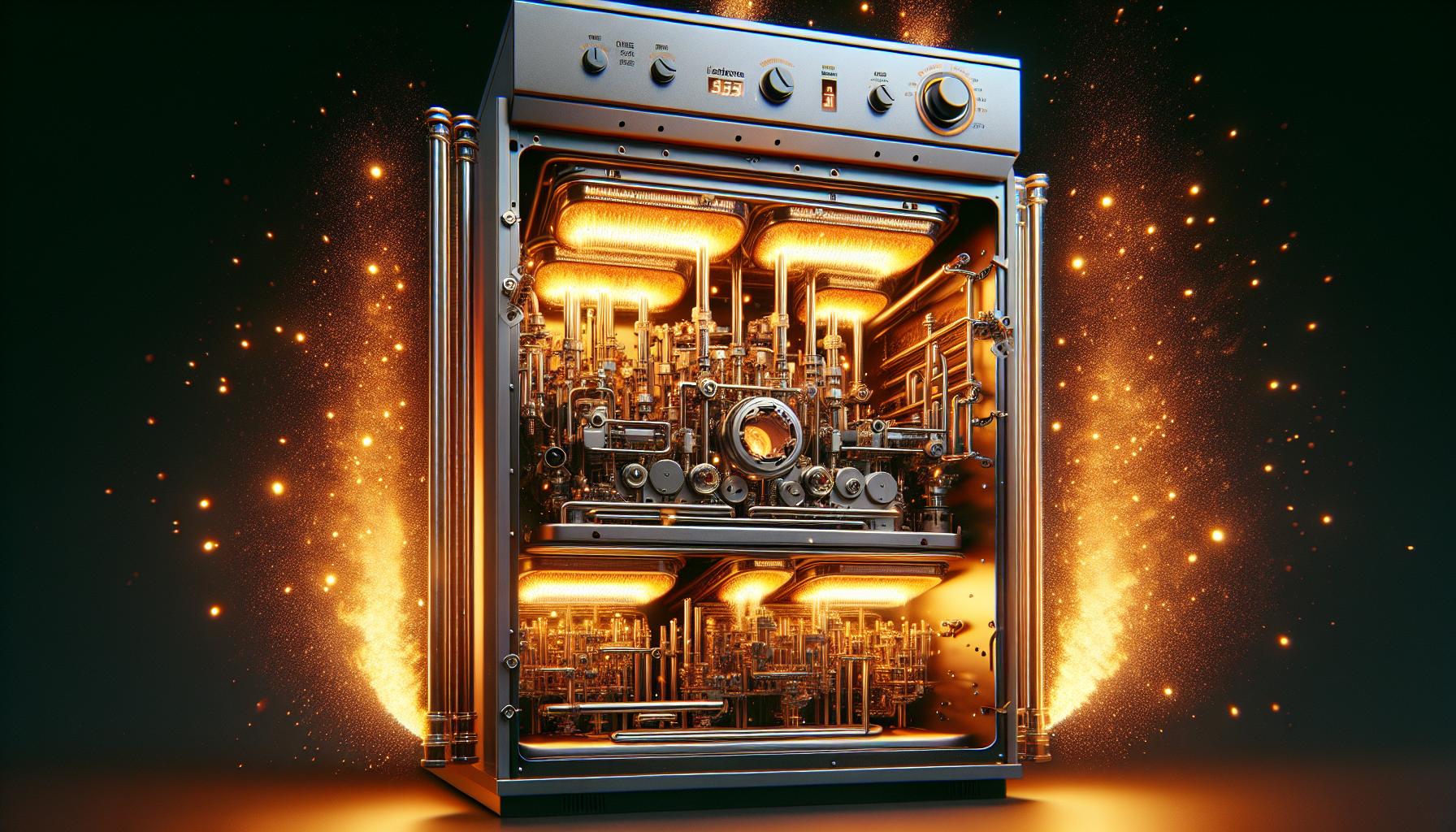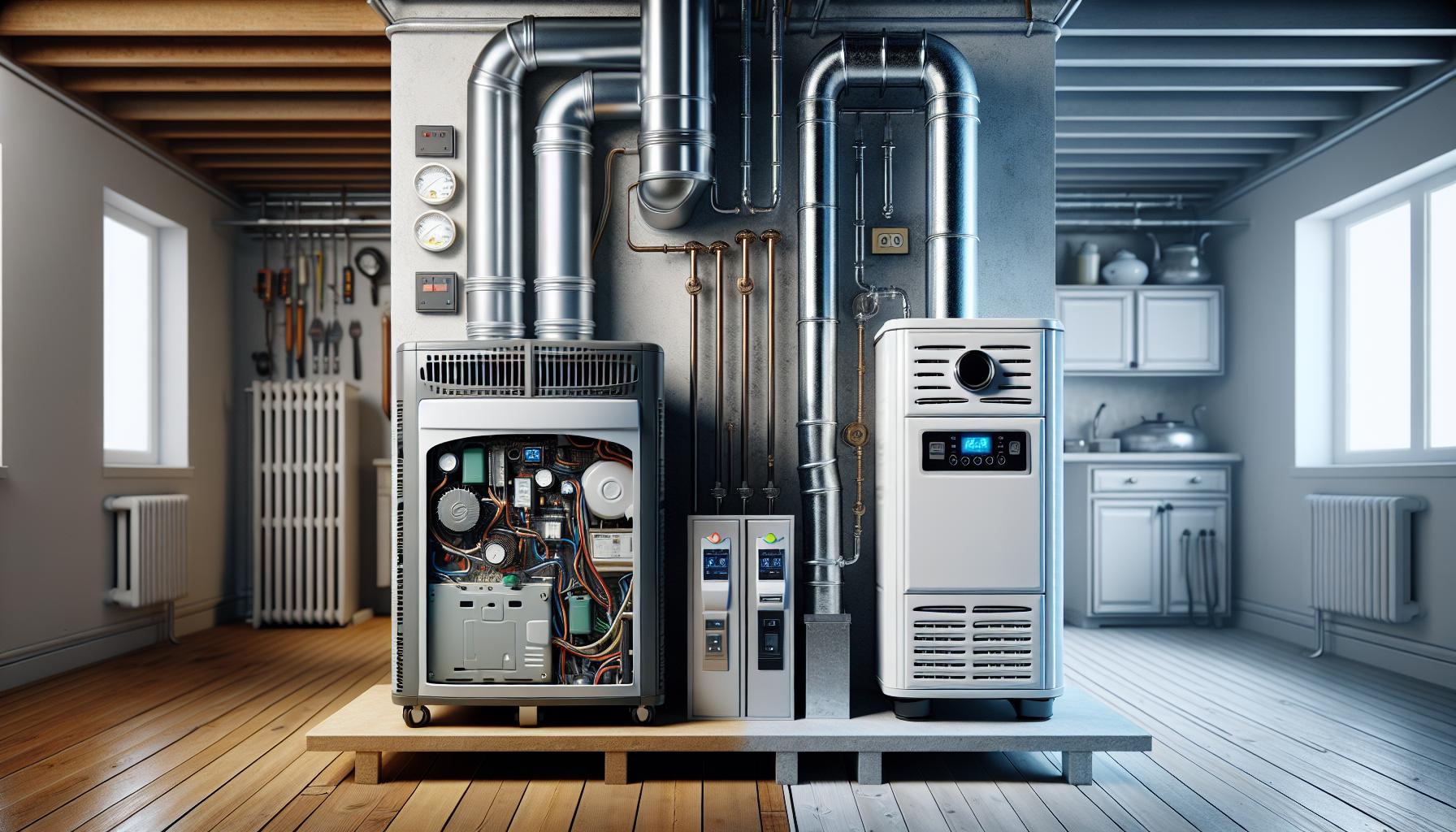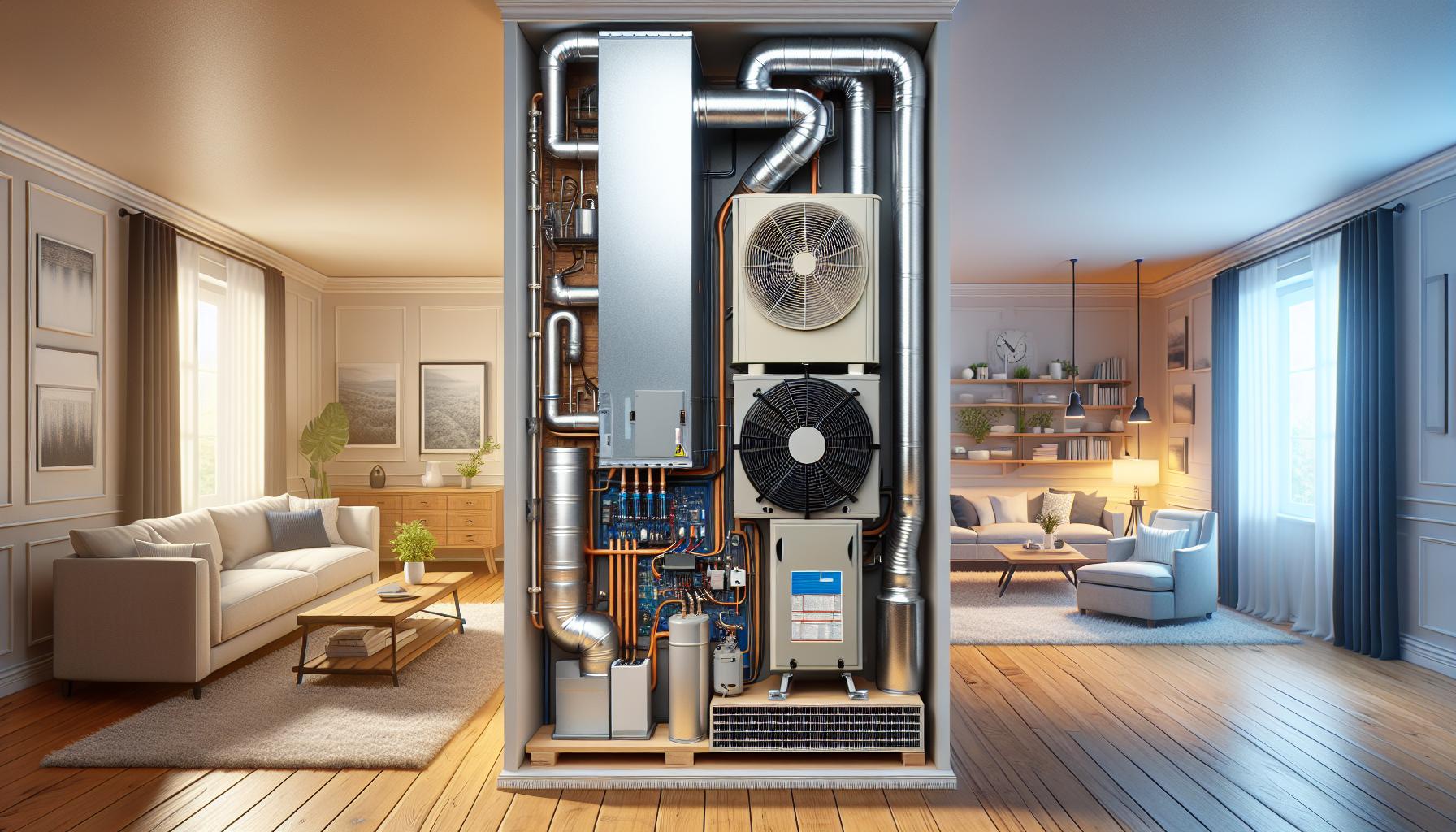Deciding between a heat pump and a gas furnace for your home heating can feel like a daunting task. With both systems having distinct methods of operation, it’s crucial you understand the differences to make a choice that suits your needs.
In this article, you’ll unravel the myths surrounding heat pumps and gas furnaces, exploring how each system performs, their energy efficiency, and the impact of your local climate on their operation. Whether you’re looking to replace an old heating system or considering the best option for a new build, you’ll find the essential facts here to guide your decision.
What is a heat pump?
How Does a Heat Pump Work?
A heat pump is an energy-efficient device designed to transfer heat from one location to another. During colder months, it functions by extracting heat from outdoor air or ground sources and moving it indoors. While in summer, the process is reversed to provide cooling, acting much like an air conditioner. Heat pumps use electricity to operate a compressor and a refrigerant substance to facilitate the heat transfer in a cycle which includes evaporation and condensation.
Advantages of a Heat Pump
- Energy Efficiency: Heat pumps don’t generate heat; they move it, which consumes less energy compared to furnaces that burn fuel to create warmth.
- Lower Operating Costs: Generally, heat pumps incur fewer costs over time due to their efficient use of electricity, potentially leading to lower utility bills.
- Environmental Impact: Since they rely more on electricity and less on burning fossil fuels, heat pumps are considered a greener alternative, reducing your carbon footprint.
- Heating and Cooling: Heat pumps offer a two-in-one solution by providing heating in the winter and cooling in the summer, ensuring your home is comfortable year-round.
- Safe Operation: Heat pumps are considered safer than combustion-based heating systems as they do not rely on burning fuel which poses risks such as carbon monoxide poisoning.
- Qualifies for Incentives: Many regions offer incentives for installing energy-efficient heat pumps, making them an economically attractive option.
- Higher Initial Costs: The upfront cost for installing a heat pump tends to be higher than that for furnaces, primarily due to the technology and installation complexity.
- Climate Limitations: While heat pumps can be effective even in colder temperatures, their efficiency diminishes as it gets colder, particularly below freezing point. This may necessitate a supplementary heating source in extreme climates.
- Maintenance: Though it might be less intense than other heating systems, heat pumps still require regular maintenance to ensure efficient operation.
- Longevity: Generally, the lifespan of a heat pump is shorter compared to some traditional heating systems, especially if not properly maintained.
Remember, the performance of your heat pump will greatly depend on having it properly sized and installed by a certified professional.
What is a gas furnace?

How Does a Gas Furnace Work?
A gas furnace heats your home by burning natural gas or propane. The process begins when the thermostat detects a need for heat, signalling the furnace. A gas valve opens, and the burner ignites the fuel, producing a controlled flame. Heat from the combustion is transferred to a heat exchanger, where cold air from your home is warmed as it passes over. This newly heated air is then pushed through ducts by a blower fan and delivered to various rooms. The combustion gases produced in this process are safely vented outside your home.
Advantages of a Gas Furnace
- Powerful Heating: Gas furnaces provide robust and reliable heating, capable of quickly warming a home even in the coldest weather.
- Immediate Warmth: Unlike some systems that can take a while to ramp up, gas furnaces produce heat as soon as they’re turned on.
- Widespread Availability: Most urban areas have established natural gas infrastructure, making gas furnaces a convenient option for many homeowners.
- Cost-Effective Fuel: Natural gas is typically less expensive than electricity, translating to lower operating costs for gas furnaces compared to electric heaters.
- High Energy Consumption: Gas furnaces are less energy-efficient than heat pumps, often using more energy for the same output of heat.
- Installation Challenges: If you don’t have existing ductwork, installing a gas furnace can be costly and invasive, as ducts must be threaded through your home.
- Maintenance Requirements: Furnaces require regular cleaning and maintenance to prevent malfunctions and potential fire hazards.
- Inconsistent Temperature: Gas furnaces may produce varied indoor temperatures since they cycle on and off throughout the day.
- Indoor Air Quality Concerns: The movement of hot air can circulate more dust, potentially decreasing your home’s indoor air quality.
Efficiency comparison

Energy Efficiency of a Heat Pump
Heat pumps stand out for their ability to transfer more energy than they consume. This attribute makes them highly energy-efficient. In ideal conditions, some heat pumps operate at up to 400% efficiency, meaning they deliver four times the amount of energy they use. The operational efficiency largely depends on the climate, significantly benefiting mild winter regions. In these areas, heat pumps consistently use less source energy on average when compared to gas furnaces. They can heat efficiently until the outside temperature drops below freezing, beyond which their efficiency diminishes.
Energy Efficiency of a Gas Furnace
When discussing gas furnaces, a key model to consider is the Carrier Infinity 98, which boasts 98.5% efficiency AFUE (Annual Fuel Utilization Efficiency). High-efficiency gas furnaces like these convert almost all the fuel to heat, reflecting impressive efficiency rates. However, their efficiency advantage often becomes more pronounced in colder climates where high-efficiency heat pumps might struggle to maintain their operational efficiency. Gas furnaces deliver powerful and immediate warmth, which is particularly beneficial during harsh winters.
Cost-Effectiveness Comparison
Making a cost-effectiveness decision involves assessing both initial installation expenses and lifetime operational costs. When upgrading a heating system, homeowners might face substantial upfront costs, particularly if switching system types. Here is a breakdown of upgrade costs and estimated annual savings for a typical family home:
| Upgrade Scenario | Estimated Upgrade Costs | Estimated Annual Energy Cost Savings |
|---|---|---|
| Gas Furnace to Gas Furnace | £4,000–£7,000 | 20% |
| Gas Boiler to Gas Boiler | £7,000–£12,000 | 16% |
Despite a high-efficiency heat pump’s superior energy transfer capabilities, the lower cost of natural gas can tilt the lifetime operating costs in favour of gas furnaces in some regions. Invariably, affordability of the energy source is region-specific and must be considered when weighing heat pumps against gas furnaces.
Environmental Impact Comparison
Heat pumps run on electricity and do not directly use fossil fuels, positioning them as more sustainable heating options. They lower greenhouse gas (GHG) emissions compared to traditional heating methods that rely on fossil fuels. In terms of indoor air quality, heat pumps present fewer safety concerns as they do not risk carbon monoxide leaks which are associated with oil or gas furnaces that are not properly maintained. Heat pump technology also contributes to energy waste reduction at a faster rate than gas furnaces, enhancing their eco-friendliness. However, the actual environmental footprint may vary depending on the source of electricity generation, with renewable sources offering the lowest impact.
Heating capacity and performance

Understanding the heating capacity and performance of heat pumps compared to gas furnaces is crucial as you decide which system is right for your home. The efficiency of these systems varies greatly with climate, so it’s essential to consider your local weather patterns.
Performance in Cold Climates
Heat pumps have come a long way and can now operate in sub-freezing temperatures. Modern heat pumps can extract heat from the air even when the temperature dips below freezing. However, it’s important to note that their efficiency does wane as the temperature drops. A heat pump’s Coefficient of Performance (COP), which measures its heating efficiency, decreases in colder climates. Gas furnaces, in contrast, are not influenced by the outside temperature in the same way. They burn fuel to generate heat internally, ensuring consistent performance and heat output, regardless of how cold it gets outside. This makes gas furnaces a reliable option when temperatures consistently fall below 0°C.
In regions where winter temperatures are harsh, heat pump technology may include a supplemental heating source to maintain comfort levels. For example, a dual-fuel system uses a heat pump for mild cold weather but switches to a gas furnace when the temperature plunges, ensuring optimal performance and energy usage.
Performance in Mild Climates
In areas where winter temperatures are moderate, typically ranging from 3-4°C to 15°C, heat pumps are particularly effective. They maintain high efficiency because the temperature differential between the inside and outside of your home is smaller. This means the heat pump requires less energy to move warmth from the outside to the inside. In these conditions, you’ll find that a high-efficiency heat pump can achieve efficiencies over 300%, translating to significant energy savings on your heating bills.
Consider a practical scenario: A homeowner living in a mild climate area, such as the southern parts of the UK, would likely experience optimal performance and comfort from a heat pump due to relatively higher winter temperatures that allow heat pumps to operate efficiently without overexerting themselves.
Performance in Extreme Temperatures
For those living in areas that experience both extremely hot summers and bitterly cold winters, choosing the right system can be challenging. Dual-fuel systems become more attractive under these conditions. These systems alter between a heat pump and a gas furnace depending on which is the most efficient at any given temperature. When the mercury soars, the heat pump can reverse its operation to act as an air conditioner, providing efficient cooling. Conversely, in the depths of winter, the gas furnace takes over, providing reliable and constant heating.
The potential savings from a heat pump in regions with significant temperature ranges can be substantial, but only if the system is correctly sized and installed for your home. For example, in a dual-fuel system, the heat pump will typically serve as the primary heating source until the outdoor temperature drops to a point where the gas furnace becomes more economical to run, seamlessly maintaining comfort.
Installation and Maintenance
Installation and maintenance
When considering a heat pump or gas furnace for your home, it’s important to understand the particulars of installation and ongoing maintenance to ensure optimal functionality and efficiency. Let’s delve into what you need to know.
Installation Requirements for a Heat Pump
Heat pumps offer a level of flexibility during installation. They can be a viable choice whether or not your home already has ductwork.
- Ductless systems: Mini-split heat pumps can be mounted directly onto the walls of rooms, bypassing the need for ductwork and making them ideal for homes without existing air ducts or for room-specific heating and cooling.
- Outdoor unit space: Typically, 24 inches of clearance is required around the outdoor unit to facilitate airflow and service access.
- Indoor air handler: The indoor unit often requires less space and can sometimes be wall-mounted.
For DIY enthusiasts, certain heat pump kits are available for self-installation. However, for full central systems, professional installation is recommended, particularly due to the necessary handling of refrigerants, which requires licensure.
Installation Requirements for a Gas Furnace
Installing a gas furnace is a more complex process, necessitating expert attention, particularly due to the fuel supply considerations.
- Ductwork: Existing ductwork is a prerequisite unless you’re willing to undertake the additional expense and construction of installing new ductwork.
- Fuel lines: If not already in place, installing fuel lines for a gas furnace can be costly and requires professional handling to ensure safety.
- Indoor placement: A gas furnace typically requires at least 30 inches of clearance on all sides and must be housed indoors, away from living spaces due to the potential risk of carbon monoxide poisoning.
Due to the potential hazards involved with gas furnaces — such as gas leaks and carbon monoxide emissions — installation is best left to certified professionals.
Maintenance Requirements for a Heat Pump
Heat pumps are fairly low-maintenance, but regular servicing can greatly extend their lifespan and maintain efficiency.
- Air filters: Like furnaces, replacing or cleaning air filters is a task most homeowners can manage on their own.
- Annual check-ups: Both the outdoor and indoor units should be cleaned and inspected at least annually by a professional to keep the system running smoothly.
- Clearances: Ensuring the outdoor unit remains clear of debris and has proper clearance at all times is crucial for efficiency.
Maintenance Requirements for a Gas Furnace
Regular maintenance of a gas furnace is critical both for efficiency and safety.
- Air filters: These need to be replaced regularly by the homeowner to prevent airflow blockage and maintain air quality.
- Annual inspections: Professional servicing is recommended annually to check for any gas leaks or issues with the burners and heat exchanger.
- Space and safety: Maintaining the clearance around the furnace is necessary, as is ensuring that there are working carbon monoxide detectors in the home.
Maintaining your heating system, whether it’s a heat pump or gas furnace, is not just about efficiency and extending lifespan; it’s also a matter of safety and comfort in your home. Regular checks and servicing align with best practices for both system types and are something you’ll need to factor into your decision-making process.
Cost considerations
When weighing the options between heat pumps and gas furnaces, it’s crucial to look at the costs involved. You’ll find that both the initial setup and the long-term running costs differ significantly. Let’s delve into the cost breakdowns for each.
Initial Cost of a Heat Pump
Heat pumps are a bit more complex when it comes to initial costs. Even though high-efficiency heat pumps can be a feasible option in milder climates, they require both an outdoor unit and an air handler, which can bump up installation expenses. While prices vary widely based on size and type of system, the starting cost is typically higher for heat pumps than for gas furnaces. This expense also includes the labor involved in installing the units.
- More expensive upfront than furnaces
- Require outdoor and indoor unit installation
Initial Cost of a Gas Furnace
In comparison, gas furnaces have a lower initial installation cost. This is primarily due to the simpler nature of the technology involved. Most homes are already equipped with the necessary ductwork, which simplifies the installation process. However, if you’re adding gas lines or need a major overhaul of existing systems, the costs can increase substantially.
- Typically cheaper to install than heat pumps
- Cost can increase if extensive work is needed
Operating Cost Comparison
Operating costs between heat pumps and gas furnaces can be judged on different criteria such as the price of utilities and system efficiency. Generally, heat pumps are known for their energy efficiency, especially in moderate climates where they use less electricity to transfer heat compared to gas furnaces generating it.
| Heating System | Operating Cost |
|---|---|
| Heat Pump | Generally cheaper |
| Gas Furnace | Can be more costly |
However, keep in mind that a heat pump’s efficiency drops in very cold weather, potentially leading to higher electricity bills during those times.
Lifespan and Durability Comparison
Finally, it’s essential to consider the expected lifespan and durability of your heating system. Heat pumps generally last around 15 years, provided they’re well-maintained with regular servicing. In contrast, gas furnaces can often exceed 20 years of service with proper maintenance. Wear and tear from the local climate and usage patterns also significantly affect longevity.
- Heat pumps last around 15 years with maintenance
- Gas furnaces can last over 20 years
Each system’s durability should play into your cost analysis when deciding which heating option fits your specific needs. Remember that regular maintenance is key to extending the lifespan and ensuring the efficiency of any heating system.
Conclusion
Deciding between a heat pump and a gas furnace hinges on your specific needs and circumstances. If you’re seeking energy efficiency and live in a moderate climate, a heat pump could be your best bet despite its higher upfront cost. For those in colder regions or looking for a more budget-friendly installation, a gas furnace might be the way to go. Remember that longevity and performance are closely tied to regular maintenance so whatever your choice, keep up with your system’s care to maximise its lifespan. Your decision will shape your home’s comfort and energy consumption for years to come so weigh your options carefully.
